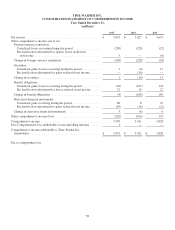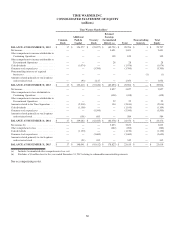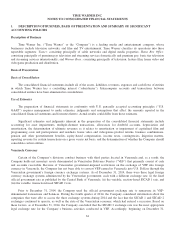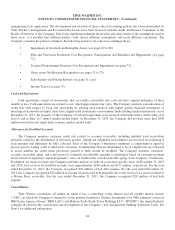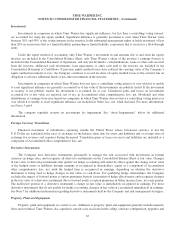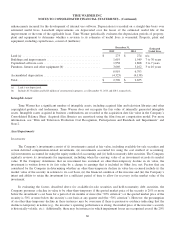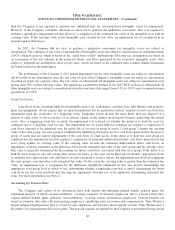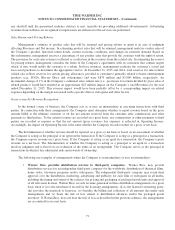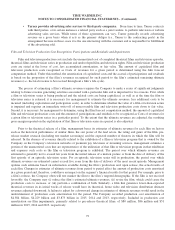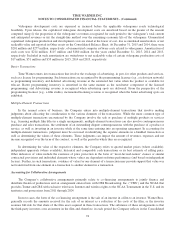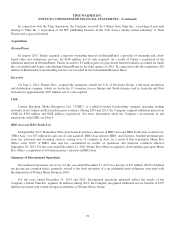Time Magazine 2015 Annual Report Download - page 82
Download and view the complete annual report
Please find page 82 of the 2015 Time Magazine annual report below. You can navigate through the pages in the report by either clicking on the pages listed below, or by using the keyword search tool below to find specific information within the annual report.TIME WARNER INC.
NOTES TO CONSOLIDATED FINANCIAL STATEMENTS - (Continued)
then the Company is not required to perform any additional tests for assessing those intangible assets for impairment.
However, if the Company concludes otherwise or elects not to perform the qualitative assessment, then it is required to
perform a quantitative impairment test that involves a comparison of the estimated fair value of the intangible asset with its
carrying value. If the carrying value of the intangible asset exceeds its fair value, an impairment loss is recognized in an
amount equal to that excess.
In 2015, the Company did not elect to perform a qualitative assessment for intangible assets not subject to
amortization. The estimates of fair value of substantially all intangible assets not subject to amortization are determined using
a DCF valuation analysis, which is based on the “relief from royalty” methodology. Discount rate assumptions are based on
an assessment of the risk inherent in the projected future cash flows generated by the respective intangible assets. Also
subject to judgment are assumptions about royalty rates, which are based on the estimated rates at which similar tradenames
are being licensed in the marketplace.
The performance of the Company’s 2015 annual impairment test for other intangible assets not subject to amortization
did not result in any impairments since the fair value of each of the Company’s intangible assets not subject to amortization
exceeded its respective carrying value. The fair values of substantially all intangible assets not subject to amortization were
greater than 30% of their carrying values. The significant assumptions utilized in the 2015 DCF analysis of substantially all
other intangible assets not subject to amortization were discount rates that ranged from 9.5% to 10.0% and a terminal revenue
growth rate of 3.25%.
Long-Lived Assets
Long-lived assets, including finite-lived intangible assets (e.g., tradenames, customer lists, film libraries and property,
plant and equipment), do not require that an annual impairment test be performed; instead, long-lived assets are tested for
impairment upon the occurrence of a triggering event. Triggering events include the more likely than not disposal of a
portion of such assets or the occurrence of an adverse change in the market involving the business employing the related
assets. Once a triggering event has occurred, the impairment test is based on whether the intent is to hold the asset for
continued use or to hold the asset for sale. The impairment test for assets held for continued use requires a comparison of
cash flows expected to be generated over the useful life of an asset or group of assets (“asset group”) against the carrying
value of the asset group. An asset group is established by identifying the lowest level of cash flows generated by the asset or
group of assets that are largely independent of the cash flows of other assets. If the intent is to hold the asset group for
continued use, the impairment test first requires a comparison of estimated undiscounted future cash flows generated by the
asset group against its carrying value. If the carrying value exceeds the estimated undiscounted future cash flows, an
impairment would be measured as the difference between the estimated fair value of the asset group and its carrying value.
Fair value is generally determined by discounting the future cash flows associated with that asset group. If the intent is to
hold the asset group for sale and certain other criteria are met (e.g., the asset can be disposed of currently, appropriate levels
of authority have approved the sale, and there is an active program to locate a buyer), the impairment test involves comparing
the asset group’s carrying value to its estimated fair value. To the extent the carrying value is greater than the estimated fair
value, an impairment loss is recognized for the difference. Significant judgments in this area involve determining the
appropriate asset group level at which to test, determining whether a triggering event has occurred, determining the future
cash flows for the assets involved and selecting the appropriate discount rate to be applied in determining estimated fair
value. For more information, see Note 2.
Accounting for Pension Plans
The Company and certain of its subsidiaries have both funded and unfunded defined benefit pension plans, the
substantial majority of which are noncontributory, covering a majority of domestic employees and, to a lesser extent, have
various defined benefit plans, primarily noncontributory, covering certain international employees. Pension benefits are
based on formulas that reflect the participating employees’ qualifying years of service and compensation. Time Warner’s
largest defined benefit pension plan is closed for new employees and frozen to future benefit accruals. Time Warner uses a
December 31st measurement date for its plans. The pension expense recognized by the Company is determined using certain
68


